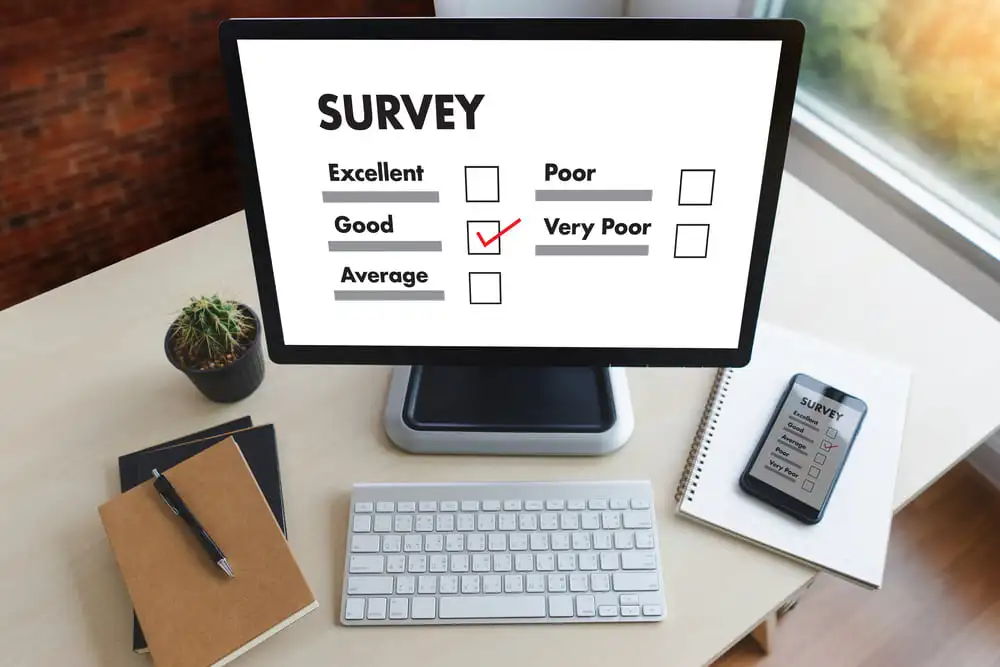In this ever-changing landscape of today’s workforce, employee engagement plays a crucial role in the success of the organization. Organizations are realizing the importance of understanding and enhancing employee satisfaction, motivation, and overall well-being. One of the powerful tools to measure employee engagement is the employee engagement survey.
These surveys act as invaluable tools, providing insights into various aspects of the workplace. These surveys are significant and well crafted for navigating the terrain of employee satisfaction, communication, leadership, and overall workplace culture.
What do you mean by Employee Engagement?
Employee engagement refers to the emotional commitment, a sense of purpose, involvement, and enthusiasm that employees bring to their work and thus that helps in the overall well-being of the organization. It is a concept that goes far beyond mere job satisfaction.
Your employees may seem happy and satisfied but the question is are they truly engaged?
Engaged employees are the ones who not just come to the office for the sake of doing the job but are also deeply invested in their roles. They align their personal goals with the objectives of the organization and contribute to the success of your organization.
Engaged employees bring more productivity, creativity, and commitment to their work, leading to increased productivity and growth of the organization.
The key components of employee engagement include:
- Emotional Commitment
- Sense of Purpose
- Involvement and Initiative
- Alignment with Organizational Values
- Continuous Learning and Development
- Recognition and Feedback
- Work-Life Balance
- Effective Leadership
- Collaborative and Inclusive Culture
- Adaptability and Resilience
Organizations that prioritize and encourage employee engagement often create a workplace where individuals not only perform well but also find fulfillment and purpose in their professional work. Some of its benefits include:
- Increase in productivity
- Improvement in Organizational performance
- Low Employee turnover rates
- Enhance Employee satisfaction
- Positive Organizational culture
What are the ways to engage your employees?
As you have seen employee engagement is very crucial for maintaining a positive and productive work environment.
So the question is, as an HR how can you keep your employees engaged?
Following are some of the ways to engage your employees:
Maintain Clear Communication:
It is very important to maintain transparent and clear communication about the organization’s goals and objectives to employees. Regularly share updates and changes to keep your employees informed and thus involved.
Give Acknowledgment and Rewards:
You generally give feedback to your employees immediately if their performance is poor in the same way, give recognition to the ones that perform very well. This will boost their morale and motivate them. Thus, reward your employees for their hard work and achievements.
Provide Career Advancement Opportunities:
The main focus of employees is to advance in their careers. Thus Investing in their growth demonstrates commitment and increases loyalty. Offer skill development opportunities like regular training programs, workshops, etc., and encourage them to take up new challenging tasks.
Promote Employee Participation in Decision-Making:
It is a good practice to involve employees in some decision-making processes like the ones that affect their work. Ask for their input or feedback and try to keep them in the loop. This promotes a sense of ownership and lets them take ownership or responsibility for their choices.
Create a Positive Organizational culture:
Create a positive workplace culture that gives value to collaboration, inclusivity, and diversity. This supportive culture will help in engaging your employees effectively as they will feel supported and motivated. Try to promote a culture where employees can share ideas, celebrate their collaborative efforts, and make them feel valued and appreciated.
Organize Team Building Activities:
Team building activities help to maintain a positive work environment and also keep your employees engaged. They involve activities that are designed to enhance collaboration and communication among team members. These activities help build relationships, enhance communication, boost morale and motivation, encourage creativity, strengthen team dynamics, facilitate conflict resolution, and create a sense of belonging. This contributes to the overall well-being and effectiveness of the team, leading to a more successful organization.
Unlock Workplace Excellence!
How to Measure Employee Engagement?
Now that you know how important is employee engagement for the welfare of your organization the question now comes how can you measure it?
Measuring employee engagement is essential in understanding where your employees stand, their satisfaction, and commitment levels.
According to the measurement of employee engagement done by Gallup in November 2023, the trends of the report show that 33% of U.S. employees are actively engaged, and 17% are disengaged. This engagement rate has reduced from 2020 which was 36% but higher than the 26% when the measurement was started in 2000. This shows that organizations are working towards engaging their employees.
One of the most common methods of measuring employee engagement is the employee engagement survey.
What is the Employee Engagement Survey?

The Employee Engagement Survey is a tool you can use for your organization to gauge the level of engagement and satisfaction among your employees. These surveys have a primary goal of collecting insights and feedback on various aspects of the work environment, organizational culture, leadership, and overall job satisfaction.
You get to know the thought process of your employees and their attitude towards work. Organizations can use this information to pinpoint areas for development and put plans in place to enhance employee engagement.
Employee Engagement surveys are generally conducted anonymously to have completely honest feedback from the employees. This collected data is then used to identify the strengths and weaknesses and thus identify areas of improvement.
Organizations use these insights to develop strategies and initiatives that enhance overall employee satisfaction, motivation, and productivity. Regularly conducting such surveys is considered a good practice for organizations committed to maintaining a positive and productive work environment.
What are the key steps in framing Employee Engagement Surveys?
Measuring employee engagement through surveys requires several steps to ensure the effectiveness and accuracy of the process. Following are the steps you can follow to conduct an employee engagement survey:
1. Define your Objectives:
The first step is to clearly outline the objective or purpose of the survey. It is essential to understand why you want to measure employee engagement and what specific aspects you are interested in exploring.
Is your focus on overall job satisfaction, specific aspects of the work environment, or any other particular issue?
This will help you to tailor your survey accordingly and collect the necessary data.
2. Choose a Survey Tool:
Now that you have the objectives the next step is to select the survey tool that suits your needs. Choose a reliable and user-friendly tool that meets your needs and budget. Consider factors like anonymity, data security, and reporting capabilities. There are various online survey platforms available, such as Zimyo Engage, Google Forms, etc.
3. Design the right Survey Questionnaire:
Create a set of questions that align completely with the objectives you have set. Ensure that they are clear, unbiased, and relevant to the experiences of the employees. It should cover a broad range of topics that capture the various aspects of employee engagement like leadership, communication, career growth, organizational culture, etc.
Also, ensure the survey includes both closed-ended and open-ended questions for quantitative and qualitative insights.
4. Ensure Anonymity:
For the employee engagement survey to run well as per your objectives it is very important to make sure that it’s anonymous. Communicate with your employees that their responses will be kept confidential then only you can expect honest and genuine feedback.
Tell them clearly that the purpose is not to identify individual responses but to gather collective insights. This will foster an environment where employees feel comfortable providing their honest responses.
5. Set a Time Frame:
It is important to set a specific timeframe for the survey. Ensure that employees have enough time to respond to the questions but at the same time, it is important to keep a deadline to maintain the momentum of the survey. Thus clearly set the start and end date of the survey. You can also decide the frequency of the survey.
6. Gather and Analyze Data:
Now that the survey is complete, the next step is to collect the data and analyze it to identify the pattern. You can analyze quantitative data by the survey tool and can check manually the qualitative data. Thus identify the strengths and weaknesses so that you can work on the area that needs improvement.
7. Take Action:
After the analysis and interpretation of the data are done, now it’s time to take action. Collaborate with the relevant stakeholders to prepare an action plan based on the results. Ask for initiatives and clearly outline the steps to address the issues.
Encourage employees to participate in the implementation of the action plan and the changes thus increasing employee engagement.
8. Monitor Progress:
It is imperative to regularly monitor the progress of your defined action plan. Keep track of the changes and their impact to assess the improvement. Adjust your action plan and strategies as per the changes. Try to send follow-up surveys to track improvements and identify new areas for focus.
By regularly measuring employee engagement through surveys and taking proactive steps to address issues, organizations can create a positive work environment, improve employee satisfaction, and ultimately enhance overall performance and productivity.
7 Tips for Preparing the Right Questions
Surveys should not be conducted just for the sake of it, they should contain the right questions for obtaining meaningful insights. Look below for some of the tips for the right survey questions to increase employee engagement:
💡Keep the language Simple: The questions should be clear, concise, and simple so that the employees can quickly understand their meaning. Try not to use jargon to avoid any confusion.
💡Use Mix of Question Types: Add a variety of questions that can analyze the data both qualitatively and quantitatively and give depth to it. The mixed question types can include multiple choice, open-ended, Likert scale, drop-down, rating scale, etc.
💡Frame Questions Positively: When you ask open-ended questions that are challenging or that require an area of improvement, frame them positively. For example instead of asking questions like” What do you dislike about your organizational culture?” you can rather ask, “What aspects of your organizational culture can be improved?” Always try to maintain a balance between positive and constructive questions to asses both the strengths and areas for improvement.
💡Add some Personalized Questions: Try to add questions targeting your employees’ experiences. This makes them feel that their contributions and hard work are being recognized and appreciated. This helps in increasing employee engagement.
💡Ask for Suggestions: It is a good practice to include questions that invite employees to share their ideas and suggestions, this will thus give you room for improvement. For example, you can ask questions like “How can we improve the work environment of our organization?”
💡Pay attention to Survey Length: Be mindful of the length of the survey while you prepare it. This step is important to avoid survey fatigue. If workers believe the survey is worth their time, they are more likely to participate.
💡Express Appreciation: At the beginning and conclusion of the survey, acknowledge the employees’ time and input. A positive tone helps to encourage goodwill and get honest and helpful feedback from the employees.
By following these tips, you can create a survey that not only gathers valuable insights but also keeps employees engaged throughout the process.
Top 40 Employee Engagement Survey Question Examples

Now that you have understood how important is employee engagement for your organization. The right survey questions are very important. To assist organizations in creating effective surveys, the following is a collection of employee engagement survey question examples, organized into key categories.
Job Satisfaction Survey Questions
Job satisfaction is a fundamental aspect of employee engagement. It shows how happy and contented employees are in their positions, which affects their commitment, drive, and general well-being. You can look below for some of the top survey question examples that help you understand the satisfaction levels of your employees:
- How happy are you in your current position?
- Do you think the skills and qualities you have are being used effectively in your job?
- How fascinating and demanding do you find your work?
- How pleased are you with the organization’s professional development opportunities?
- Do you think your contributions at work are appreciated and acknowledged?
- To what extent do you find the work-life balance in your current position satisfactory?
- How much do you think your current position and your long-term professional aspirations align?
- To what extent does your reporting manager help you advance your career?
- Do you feel glad to mention to others that you are employed by this organization?
- What level of satisfaction do you have with your department’s general work environment?
Effective Communication Survey Questions
As you already know effective communication is very important to have healthy employee engagement. It is crucial to maintain transparent and clear communication about the organization’s goals and objectives to employees to give a clear understanding to them. Below are some of the survey question examples you can ask to keep your employees engaged:
- How pleased are you with the leadership’s communication clarity?
- Do you think your team values and listens to your comments and ideas?
- To what extent do you think departments communicate information with one another?
- How much prompt feedback on your performance do you receive?
- Do you feel at ease giving your manager or supervisor feedback?
- To what extent do you find the frequency and efficacy of team meetings satisfactory?
- Do you think you are well informed about the organization’s aims and general direction?
- To what extent do you find the platforms and instruments for communication employed at work satisfactory?
- Do you think any internal communication avenues are being underutilized?
- How effectively does leadership convey updates and changes?
Team Dynamics Survey Questions
The relationship and interaction between the team members are very essential for the employee engagement. A positive team environment encourages collaboration, trust, and a sense of belonging, contributing to the overall satisfaction of the employees. Here are some of the questions you can ask your employees and add to your employee engagement survey:
- To what extent do team members work together and provide mutual support?
- Is there a feeling of cooperation and friendship in your department?
- How much do members of the team acknowledge and appreciate each other’s successes?
- How happy are you with the degree of transparency and trust on your team?
- Do you think the aims of the team and the individual are adequately balanced?
- How effectively does your team manage and settle disputes?
- To what extent do you find team-building exercises effective?
- How comfortable are you voicing your thoughts during team discussions?
- Are there opportunities for cross-functional collaboration that could be improved?
- To what extent can team leaders create a welcoming and constructive work environment?
Organizational Culture Survey Questions
Organizational culture significantly shapes the workplace environment, creating distinct employee experiences. A positive organizational culture promotes inclusivity, well-being, and a sense of purpose among employees. Following are some of the survey question examples you can add to your employee engagement survey:
- To what extent do team members work together and provide mutual support?
- Is there a feeling of cooperation in your department?
- How much do members of the team acknowledge and appreciate one another’s successes?
- How happy are you with the degree of transparency and trust on your team?
- Do you think the aims of the team and the individual are adequately balanced?
- How effectively does your team manage and settle disputes?
- To what extent do you find team-building exercises effective?
- How comfortable are you voicing your thoughts during team discussions?
- How well does the organization support and accommodate employee needs and preferences?
- To what extent can team leaders create a welcoming and constructive work environment?
Conclusion
You have understood that employee engagement is very crucial for the success of the organization. And to measure it the strongest tool is an employee engagement survey. We’ve covered the importance of engagement, the function of surveys, and the steps for creating, implementing, and acting upon the results.
Organizations can encourage a work environment where employees are not only present but also completely committed to their tasks, contributing to the firm’s overall success and expansion, by prioritizing employee engagement.
Zimyo Engage has extensive survey features intended to collect employee opinions and insights. Through these surveys, organizations can evaluate employee satisfaction, engagement, and general mood in the workplace. Organizations can design customized survey questions, plan surveys for regular intervals, and instantly analyze results with these surveys.
This platform offers capabilities for creating a variety of survey designs, such as engagement, satisfaction, pulse, and more. Organizations can make data-driven decisions to improve employee experience, pinpoint areas for development, and create a healthy work environment by utilizing Zimyo Engage surveys.
Remember that creating a thriving workplace is a never-ending journey, and Zimyo engagement surveys are your compass for finding the right path. For more insights schedule a demo today!




